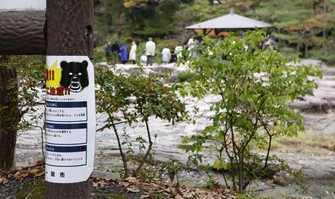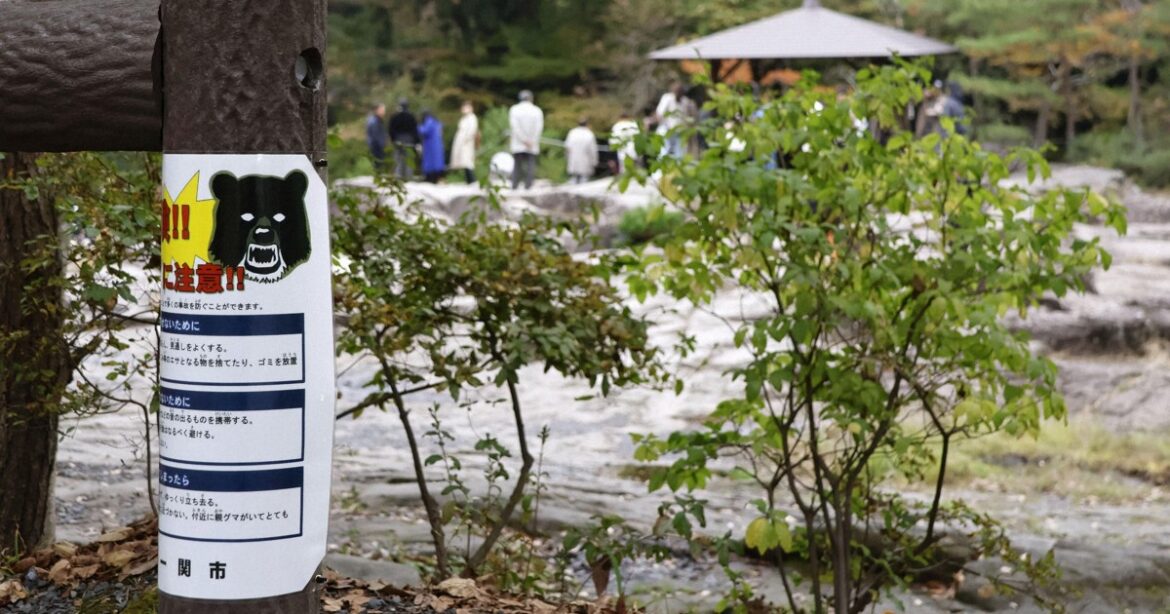
A flyer posted at the Gembikei gorge in Ichinoseki, Iwate Prefecture, in October 2025, warns visitors about the possibility of bear encounters. (Kyodo)
MORIOKA (Kyodo) — A steady stream of bear attacks in northeastern Japan is turning some tourists away from the region, hitting local businesses hard during the normally busy season of peak fall foliage.
In the Tohoku region, hotel bookings at hot spring resorts have declined sharply, public access to areas is often limited after bear sightings, and local governments are warning visitors to be vigilant about potential bear encounters.
With no immediate signs that tourists are likely to turn up at levels seen in previous years, businesses that rely on the traditionally lucrative period before winter are facing an uncertain future.
In the Gembi area of Ichinoseki, Iwate Prefecture, a man was found dead outside his house in late October after being fatally attacked by a bear.
More than 10 kilometers away sits the Gembikei gorge, a state-designated scenic spot now entering its prime span for viewing autumn leaves.
The manager of a tourist facility that displays and sells glassware assessed that fewer people were visiting the area, partially because of the bear attack, saying, “If they heard ‘Gembi’ in the news, they would probably guess it happened in this neighborhood.”
Farther north in the prefecture, in Kitakami, a male hotel worker was attacked and killed by a bear while cleaning an open-air bath in mid-October.
Motoyugeto, a Japanese-style hot spring inn located about 7 km from the hotel, has seen around 20 percent of its bookings canceled following the attack, while the number of bath use-only visitors has dropped by as much as about 70 percent on some days.
“This, coming at a peak period, hits us pretty hard,” said inn representative Hironori Takahashi.
Some hot spring businesses in the prefecture have closed their open-air bath sections out of an abundance of caution.
With a record five people killed in bear attacks in Iwate since April — of the 13 dead in such incidents nationally over the same span, as of Wednesday — some people have started avoiding the area altogether.
Eri Aoki, a 30-year-old Tokyo resident and company employee, said she scrapped her plan to go to a hot spring resort in the prefecture in early November.
“It’s scary that bears have shown up in residential areas. I will revisit the plan once bears go into hibernation in winter,” she said.
In Akita, the capital city of the neighboring prefecture of the same name, bears were repeatedly spotted in and around Senshu Park, a well-known fall foliage spot, prompting the municipal government to close it in late October.
After two bears were captured, the park reopened on Tuesday, only to be closed again after a bear was spotted several hours later.
Four people have died in bear attacks in the prefecture since April.
In the Tohoku region, Miyagi Prefecture also had a deadly bear attack, in early October.
A number of foreign tourists still visit the Narukokyo gorge in a mountainous area near Miyagi’s border with Yamagata Prefecture.
The Osaki municipal government has put up “Beware of Bears” signs in four languages at the gorge, including English and Korean, while ramping up area patrols by increasing the number of security personnel.
“We intend to raise awareness among all visitors, regardless of nationality, about bear risks,” a city official said.


AloJapan.com